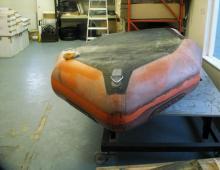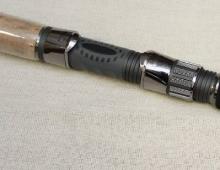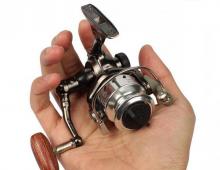Fly fishing gear selection
Fly fishing gear can only be used in this type of fishing. This is their distinguishing feature. Special features are fly line, fly reel, undergrowth, fly hooks, fasteners. The rigging is going for a specific fish.
For such fishing it is impossible to collect equipment from improvised material, from what is in stock. Gear will have to be selected specially, some can be made by hand.
The line is the second most important element of fly fishing tackle after the rod. The fly line serves as both a bite alarm and a sinker. Such an element of equipment is found exclusively in fly fishing, nowhere else. The cord allows you to make wiring in the water column, which cannot be done in any other way. With it, a small fly is delivered over a considerable distance. Of course, such a special piece of equipment has many models adapted to a wide variety of conditions. To understand all this variety and skillfully apply, you need to know the characteristics of the cords.
sinking cord
Structure
Cord - consists of a durable core covered with a polymer. The core can be a tear-resistant nylon line, a braided cord, or thin fibers.
The entire cord can be broken down into its components:
- Tip.
- front cone.
- Thickening (body, head).
- rear cone.
- End of cord.
All cords are stretchable, which negatively affects the casting. Expensive cords stretch less, as they are made using higher quality polymer materials.
The length of the cord is selected individually for the individual.
Class
There is a scale by which cords are classified, it is accepted everywhere, has the abbreviation AFTMA. According to this classification, all lines are divided into classes according to the weight of the first 9.14 meters of line (30 feet). Since this classification was invented by the Americans, then, accordingly, the weight is in feet. The class of the cord corresponds to the class of the rod. In the modern world there is a new name - ASA, but it's the same.
It is worth mentioning that not only lines, but also other fly fishing equipment is classified according to the same system, these are rods and reels.
Here is an example of catching fish with different line classes:
- 3rd-4th class - used for fly fishing on streams using dry flies and light streamers. Short throws.
- Class 5 - used for fishing on small rivers.
- Grade 6 - fishing in moderate wind. They are used for catching big flies and streamers.
- Grade 7 - fly fishing for streamers and nymphs. Used for fishing on large rivers, wading.
- Grade 8 - fishing at sea. You can fly fish with any lure in strong winds.
Watch the video for tips on choosing a cord:
Buoyancy
Cords are divided into types according to their floating properties. Various types of cords can apply bait to any horizon of the reservoir. Fly fishing line is:
- Floating (F) - This line is easy to cast. Recommended for beginners. They are delivered dry fly or light streamers and nymphs.
- Sinking, Sinking (S) - sinking lines have different sinking speeds. There is a table in which sinking lines are divided into 6 more types, and according to it, you can select the desired line by sinking speed.
- Floating with a sinking end, Floating/sinking (F/S).
- Intermediate, Intermediate - allows you to throw the bait into the uppermost layer of water.
It is generally accepted to distinguish by color the depth of immersion of the cord. Darker colors are sinking cords. It is believed that the dark color of the fish notices worse in the water. Floating cords - transparent or bright colors. The fish does not see what is above its head. But they are clearly visible to the fly fisherman.
geometric shape
Cords are divided into 2 types according to their geometric shape:
- Tapered at both ends Double Taper, DT for short, symmetrical shape.
- With a thickening at only one end in the form of a torpedo Weight Forward - WF, the body is shifted forward.
All other names are modifications of the first two forms, different in length of the cone and body.
The WF includes the “Shooting Cone” (ST) - it is difficult for a beginner to cope with it, because with an inept cast it slams loudly on the water. Due to the peculiarity of the form, it is folded and tied, which creates a significant inconvenience. To avoid this, use a basket for the cord.
DT includes the "Parallel cone" (L) - it is used extremely rarely, it has the same weight and width along the entire length. Slams hard when casting. The only plus is the very low price.
Why do we need such a variety of forms of cords? And in order to make casts at different distances and feed the fly into different layers of water.
When choosing the geometry of the cord, one must take into account their strengths and weaknesses.
The WF line, due to the forward displacement of the body, accelerates during the cast and sends the fly to a longer distance. It needs less room to accelerate and is faster. It is less affected by the wind. But at the same time, it is bad to lift such long cords out of the water.
In turn, the DT line lays on the water more smoothly and accurately on long casts. It has the best cutting quality.
Trying to do something in between, cords that would have a large set of positive qualities, manufacturers are trying to modernize existing forms. They are mainly working on improving the qualities of WF. Therefore, there appeared - Long Belly Taper, Bass Bug Taper (BBT), Nymph Tip - each has its own peculiarity.
I would like to say a few more words about the shooting head - Shoting Head (SH). This is also a subspecies of WF. It is used together with an extension (running) cord - raning.
WF cords and all their varieties are popular. It is recommended to purchase such a cord for a beginner.
Care
The cord is the most expensive part of fly fishing. It will need to be changed once or twice a year (depending on the use of gear). Replacing the cord is also justified by the fact that with aging, the cords begin to twist, “remember” the winding. Regular rewinding of the line on a spare spool when fishing is over can help get rid of this "remembering".
In order for the cord to serve you for a long time, it must be carefully handled and looked after. So, for example, make sure that the oil component does not get on the cord. For example, suntan oil or mosquito repellent. If the coil is barbed, then mechanical damage to the cord may occur. The same damage can occur if you practice casting in a place where there are knots or sharp stones. After fishing, the line should be regularly cleaned of dirt and algae. The cord is recommended to be washed with soap after fishing. The cord should be stored on a reel, in a dark place, at room temperature.
Instead of a line, hand-woven fly line can be used, treated with grease to give it the desired properties.
Coil
The fly reel should also be chosen thoughtfully. The balance and convenience of working with gear depends on the reel. Fly fishing involves the use of an inertial reel.
 The coils are manufactured using advanced technologies
The coils are manufactured using advanced technologies Requirements
By class, the reel must match the cord and rod. Equipment should be as light as possible. Therefore, manufacturers try to lighten each part of the equipment. Coils are no exception. They are made from very light metal alloys or plastics.
A fly reel doesn't have to be complicated, because by and large it's just a receptacle for line and backing. She does not participate in casting and fighting. The manufacturer indicates how much cord with backing can fit in it.
The spool on the reel should have a large diameter so that the cord “remembers” the winding turns as little as possible.
The fly reel must be balanced with and line. The easiest way to combine all this is to buy all three tackles of the same AFTMA class.
Another important requirement that applies to the coil is that it must be waterproof. And reels for sea fishing - do not be afraid of sea salt water.
Many manufacturers make quality products. For example, the Finnish company Vision. But the bearings in the coil, even in Vision, are still Japanese.
Characteristics
When choosing a reel, it is necessary to pay attention to its characteristics: capacity, type of winch, braking, balancing.
Capacity
Less capacious reels are used with rods of a smaller class. For higher classes, more line and backing are required, and, therefore, a capacious reel. So, for example, for a 12-15 class rod, in addition to the main cord, 200-300 meters of additional fishing line - backing - may be required. Such rods are used for fishing at sea or especially large fish on large and fast-moving rivers, where the presence of a large amount of fishing line on the reel is justified. At the same time, on small rivers it is more expedient to use a less capacious coil, with a short cord length. But the expression less capacious does not mean small, all fly reels must hold a lot of line. These are the features of fishing.
winding
The reel, cord, front sight must work clearly, without failures. But at the same time, in one situation, fast winding of the coil is required, in the other, slow winding. For this, models with fast winding were invented: automatic, electric, LA-coils, anti-reverse - A / R.
Automatic and electric are not popular and almost never produced. But LA-coils and A / R coils have firmly conquered the modern market.
Brake
The friction brake must have a soft stroke, so that when the fish is rapidly maneuvering, the line can unwind unhindered. This is especially important when catching powerful fish, such as salmon. It is desirable that the brake be adjustable, that is, it unwinds the cord well, and rewinds it with resistance. If this is not the case, then the cord is held by hand during winding.
Undergrowth
To smooth out the impact of the fly on the water and feed it as quietly and inconspicuously as possible, undergrowth is needed. The undergrowth should be a logical continuation of the cord. And since the cord ends in a cone, the undergrowth should also have a cone shape. Accuracy in the connection of these two parts can be achieved by selecting the cord and undergrowth from the same manufacturer.
If you fish with streamers, then the undergrowth also helps to deepen the bait.
Since the line gives a decent shadow, and this can frighten the fish, the length of the undergrowth can be large - 6-9 meters.
To connect the cord and undergrowth, connecting loops are commercially available.
Fly fishing undergrowth can be made by hand. This will save you money, because sometimes you may need up to 5 of them for one fishing trip. And it will also allow you to do what you love in the winter and try to weave tackle with your own hands. As a material, either a mounting thread is used. You can qualitatively twist the undergrowth with your own hands floating or slowly sinking. You can’t do a quickly sinking undergrowth yourself. It is difficult to find source material for this.
On the video you can see how to twist the undergrowth yourself:
In some cases, you can do without undergrowth if you catch on or nymphs. This function can be performed by a monofilament line.
In order for the fly to be changed in a short time, fasteners for fly fishing were invented. They are easy to make with your own hands from old hooks. The clasp will turn out to be miniature if you take hooks 3-6 numbers. The hook should bend well, and not break. At the first stage, you need to bite off the sting of the hook. Then bend so that the end without a sting approaches the ear, forming a loop. The clasp is ready, it is tied to a fishing line.
 Clasp - self made
Clasp - self made Hooks
Fly hooks are also special. They are made in the form of insects, those that will be knitted on them. The shape of the hooks are:
- Curved.
- Shortened.
- Elongated.
- Ring up.
- Ring down.
- With horizontal ring.
- Salmon light and heavy.
All hooks are specially marked. They are also classified in the AFTMA system, only they are divided into only 6 classes.
Folk sign: If crucian carp, dace, roach actively splash and even jump out of the water during the day and at the evening dawn, expect good weather and excellent bite the next day.



